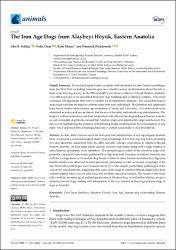| dc.contributor.author | Siddiq, Abu B. | |
| dc.contributor.author | Onar, Vedat | |
| dc.contributor.author | Mutuş, Rıfat | |
| dc.contributor.author | Poradowski, Dominik | |
| dc.date.accessioned | 2023-07-13T10:51:06Z | |
| dc.date.available | 2023-07-13T10:51:06Z | |
| dc.date.issued | 2021 | en_US |
| dc.identifier.issn | 2076-2615 | |
| dc.identifier.uri | https://hdl.handle.net/11363/5021 | |
| dc.description.abstract | Zooarchaeological studies on canine skeletal remains are rare. Faunal assemblages
from the Near East, including Anatolia, give us a valuable source of information about the role of
dogs in the Iron Age society. In the 2016 and 2017 excavations at Alaybeyi Höyük (Eastern Anatolia),
over 300 dog bones were unearthed from Iron Age buildings and workshop complex. This study
examined 143 specimens that were accessible for morphometric analysis. The zooarchaeological
analysis proved that the majority of them came from nine individuals. The dentition and epiphyseal
bone fusion further allowed their age estimation (8 adults and 1 juvenile). Two individuals were
identified as males and one as female, but the sex of the other individuals was indeterminate. The
height at withers estimations and their comparison with other archaeological dogs in Eastern Anatolia
as well as modern dog breeds showed that Alaybeyi dogs were significantly larger and heavier. It is
also worth highlighting the presence of butchering marks resulting from the consumption of dog
meat. Yet, it appeared that cynophagia had only occurred occasionally at Alaybeyi Höyük.
To date, little is known about the biological and cultural status of Iron Age dogs in Anatolia.
Here, we present a zooarchaeological study of an assemblage of 143 Iron Age dog bones, including
two dog skeletons, unearthed from the 2016 and 2017 salvage excavations at Alaybeyi Höyük,
Eastern Anatolia. At least eight adults and one juvenile individual, along with a large number of
miscellaneous specimens, were identified. The morphological status of the Alaybeyi dogs were
primarily compared to previously published Iron Age dogs from Yoncatepe in Eastern Anatolia, and
with the average mean of 18 modern dog breeds. Unlike in other Eastern Anatolian Iron Age sites,
butcher marks were observed in some specimens, indicating at least occasional cynophagy at the
site. Noticeable pathologies were found in about 5% of the sample, particularly pathologies of the
oral cavity and dentitions, suggesting that some of the dogs at Alaybeyi Höyük might have been
undernourished, had to live on solid food, and probably injured by humans. The results of this study
reflect both the morphological and biological status of Alaybeyi dogs, as well as the Alaybeyi people’s
attitudes toward dogs, adding vital information to the very limited archaeological knowledge of
dogs in Anatolia. | en_US |
| dc.language.iso | eng | en_US |
| dc.publisher | MDPI, ST ALBAN-ANLAGE 66, CH-4052 BASEL, SWITZERLAND | en_US |
| dc.relation.isversionof | 10.3390/ani11041163 | en_US |
| dc.rights | info:eu-repo/semantics/openAccess | en_US |
| dc.rights | Attribution-NonCommercial-NoDerivs 3.0 United States | * |
| dc.rights.uri | http://creativecommons.org/licenses/by-nc-nd/3.0/us/ | * |
| dc.subject | Canis lupus familiaris | en_US |
| dc.subject | Alaybeyi Höyük | en_US |
| dc.subject | Iron Age | en_US |
| dc.subject | human-dog relationship | en_US |
| dc.subject | Eastern Anatolia | en_US |
| dc.title | The Iron Age Dogs from Alaybeyi Höyük, Eastern Anatolia | en_US |
| dc.type | article | en_US |
| dc.relation.ispartof | Animals | en_US |
| dc.department | Sağlık Bilimleri Fakültesi | en_US |
| dc.authorid | https://orcid.org/0000-0001-5838-2695 | en_US |
| dc.authorid | https://orcid.org/0000-0002-8359-243X | en_US |
| dc.authorid | https://orcid.org/0000-0003-4296-3174 | en_US |
| dc.identifier.volume | 11 | en_US |
| dc.identifier.issue | 4 | en_US |
| dc.identifier.startpage | 1 | en_US |
| dc.identifier.endpage | 20 | en_US |
| dc.relation.publicationcategory | Makale - Uluslararası Hakemli Dergi - Kurum Öğretim Elemanı | en_US |
| dc.contributor.institutionauthor | Mutuş, Rıfat | |



















